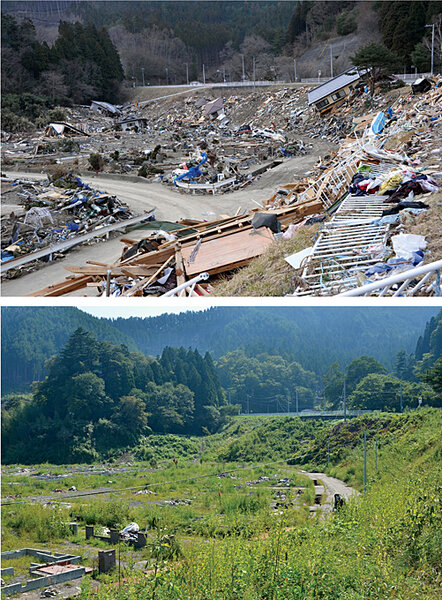Post-tsunami 'eco' vision for Japan's restart
Loading...
| Sendai, Japan
All along the once picturesque coast of northeastern Japan, the devastation wrought by the tsunami in March has also made way for a new step forward: the opportunity to rebuild using the latest sustainable technologies that would reduce dependency on coal and nuclear energy.
Under strong public pressure to rely less on nuclear power after the meltdowns at the Fukushima Daiichi nuclear power plant, officials at every level of government say such development is a top priority.
"We will make the reconstructed area a model for the rest of Japan. We will do everything we can to promote 'smart cities' and build a sustainable, low-carbon society in the region," wrote Takeshi Maeda, the minister of Land, Infrastructure, Transport and Tourism, in a recent editorial.
Draft reconstruction plans and brainstorming include ideas such as recycling disaster debris to make tsunami barriers or artificial hills, installing solar panels on new homes, farming seaweed to make biofuel, and designing compact, walkable communities.
"If we're trying to make existing towns greener, we have to deal with so many existing factors. But if we think about the entire infrastructure from the start, it's easier to incorporate these concepts," says Yasushi Okura, of the technology support division at the Environment Department in Miyagi Prefecture.
Shortages emerge
While a range of strategies to reduce the damage from future tsunamis has emerged, green planning, however, faces a number of obstacles: shortages of funds, time, coordination, and public participation.
In the steel-producing and fishing town of Kamaishi on the coast of Iwate Prefecture, the drafted plan stresses safety, preservation of local culture, and conservation of the natural environment. Instead of rebuilding heavy concrete embankments along the river, for example, it calls for a curving earthen barrier that serves double duty as a nature park. The plan does not touch on energy, which will be discussed later by a separate committee.
Kamaishi's reconstruction committee has an unusually diverse membership, including well-known architect Toyo Ito, a disaster engineering expert; town officials; and representatives from local businesses and parent-teacher organizations.
"We are emphasizing public participation. A lot of other towns are emphasizing speed," says Arata Endo, the Kogakuin University urban planner who heads the committee. Whether their innovative ideas are realized will depend on the size of the yet-to-be-negotiated third installment of the national supplementary disaster budget, he says.
Volunteer visions
Several hours south in the city of Ishinomaki, in Miyagi Prefecture, a volunteer association of more than 200 architects called ArchiAid is trying to ensure that those living in remote fishing hamlets are involved in the planning process.
Their knowledge is not only key to reviving local culture but also to preserving marine ecosystems and the economies they support, says Tohoku University architecture professor and ArchiAid founding member Yasuaki Onoda.
Mr. Onoda and his students, along with other professors belonging to ArchiAid and their students, have been interviewing residents of Ishinomaki's Oshika and Ogatsu Peninsulas, where densely forested hills drop steeply down to dozens of tiny inlets, each with its own community that fishes and cultivates seaweed and shellfish.
"Each village has a different culture and history, different geography, different kinds of fish," says Onoda. "A small river feeds each inlet, and the quality of the oyster beds depends on the quality of the forest upstream. Villagers have made huge efforts to conserve those forests. Before we do any master planning, we need to do very careful research to understand the slight differences in each biological system."
In many towns along the coast, that research is not being done. Onoda says some municipalities have rejected assistance from ArchiAid and are instead relying heavily on the advice of civil engineers, who are less likely to base their plans on the ecological knowledge of rural fishing communities.
A prominent Tokyo architect, Masahiro Harada, says that few local and prefectural governments have actively sought out architects for help with planning. "I was shocked that we haven't been called on to a greater extent," he says.
Nobuyuki Takahashi, director of the nonprofit Disaster Area Revitalization Center and manager of a shelter in Ishinomaki, says he worries that political promises of a sustainable reconstruction may translate into a handful of isolated projects rather than a wholesale redesign of how people live.
"I think the government is probably planning some wind farms or seaweed biofuel projects. What we really need is to change our lifestyles and reduce energy consumption," says Mr. Takahashi, who hopes to start an ecovillage in the disaster area.
[ Video is no longer available. ]





